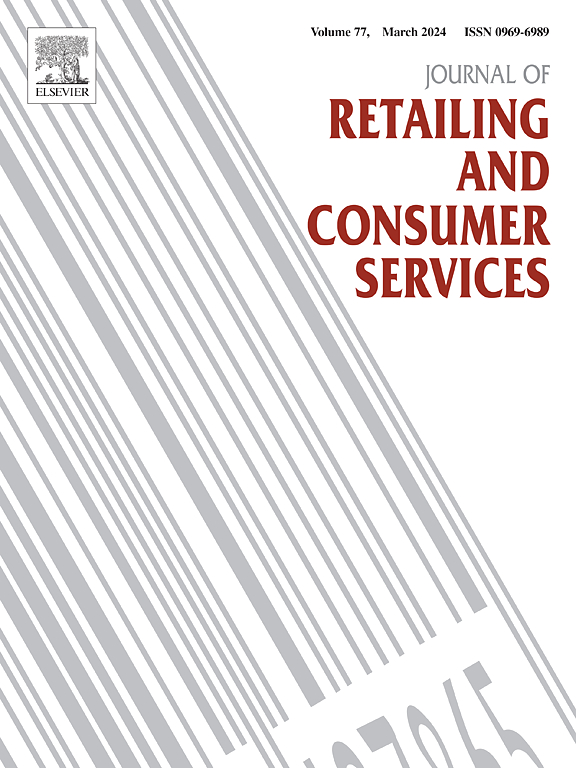Scarcity, symbolism, and social identity (3S): Unpacking drivers of conspicuous consumption of virtual gear in the metaverse
IF 13.1
1区 管理学
Q1 BUSINESS
Journal of Retailing and Consumer Services
Pub Date : 2025-07-03
DOI:10.1016/j.jretconser.2025.104396
引用次数: 0
Abstract
A research gap persists in Metaverse virtual equipment consumption, particularly in the unclear interaction mechanisms of the 3S framework (Scarcity, Symbolism, Social identity) on consumer behavior. Traditional studies often overlook gender differences, complicating the identification of complex causal relationships and multi-level pathways in virtual environments.This study employs PLS-SEM to: (1) examine the relationship between the attributes of virtual gear (scarcity, brand symbolic value, visibility, identity satisfaction and social recognition) and conspicuous consumption behaviour, with social recognition acting as a mediator; (2) determine the moderating role of emotional affordance and technology acceptance; (3) analyse gender differences in the impact pathways; and (4) utilise fsQCA to identify causal configurations associated with high conspicuous consumption behaviour. Using 550 valid samples, reliability and validity tests confirmed the robustness of the Stimulus-Organism-Response model. PLS-SEM analysis indicates that the attributes of virtual gear positively influence conspicuous consumption behaviour. However, technology acceptance does not moderate the effect of social recognition on conspicuous consumption behaviour (r = 0.014, p > 0.05), and neither brand symbolic value nor social recognition exhibits a chain mediation effect on the influence of virtual gear product scarcity on conspicuous consumption behaviour (r = 0.009, p > 0.05). Furthermore, six groups of pathways demonstrate significant gender differences. The fsQCA analysis reveals that virtual gear product scarcity and brand symbolic value are key factors in the three configurations of high conspicuous consumption behaviour. These findings provide theoretical insights for sustainable marketing strategies on virtual platforms and practical guidance for promoting rational consumption.
稀缺性、象征主义和社会身份(3S):解析虚拟装备炫耀性消费的驱动因素
meta - verse虚拟设备消费研究仍存在空白,尤其是3S框架(稀缺性、象征主义、社会身份)对消费者行为的交互机制不明确。传统研究往往忽略了性别差异,使虚拟环境中复杂因果关系和多层次途径的识别复杂化。本研究采用PLS-SEM研究:(1)考察虚拟装备属性(稀缺性、品牌符号价值、知名度、身份满意度和社会认可度)与炫耀性消费行为的关系,其中社会认可度起中介作用;(2)确定情绪提供度和技术接受度的调节作用;(3)分析影响途径的性别差异;(4)利用fsQCA识别与高炫耀性消费行为相关的因果配置。使用550个有效样本,信度和效度检验证实了刺激-生物-反应模型的稳健性。PLS-SEM分析表明,虚拟齿轮的属性对炫耀性消费行为有积极影响。然而,技术接受度并没有调节社会认同对炫耀性消费行为的影响(r = 0.014, p >;品牌符号价值和社会认可度对虚拟齿轮产品稀缺性对炫耀性消费行为的影响均不存在链式中介效应(r = 0.009, p >;0.05)。此外,六组通路表现出显著的性别差异。fsQCA分析表明,虚拟齿轮产品稀缺性和品牌符号价值是三种高炫耀性消费行为配置的关键因素。这些发现为虚拟平台的可持续营销策略提供了理论见解,并为促进理性消费提供了实践指导。
本文章由计算机程序翻译,如有差异,请以英文原文为准。
求助全文
约1分钟内获得全文
求助全文
来源期刊
CiteScore
20.40
自引率
14.40%
发文量
340
审稿时长
20 days
期刊介绍:
The Journal of Retailing and Consumer Services is a prominent publication that serves as a platform for international and interdisciplinary research and discussions in the constantly evolving fields of retailing and services studies. With a specific emphasis on consumer behavior and policy and managerial decisions, the journal aims to foster contributions from academics encompassing diverse disciplines. The primary areas covered by the journal are:
Retailing and the sale of goods
The provision of consumer services, including transportation, tourism, and leisure.

 求助内容:
求助内容: 应助结果提醒方式:
应助结果提醒方式:


